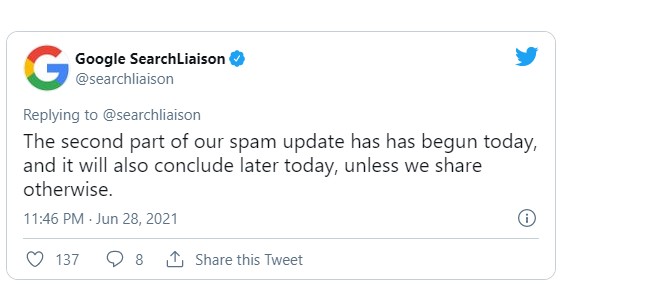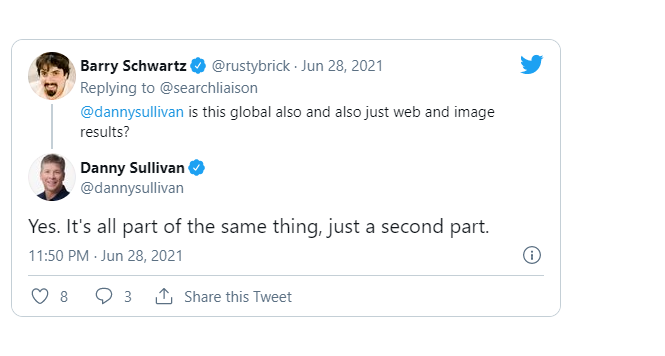After the first spam update, Google talked about the second spam update to get released soon. And finally, on June 28, 2021, they confirmed the release of the second part of the search, “spam update.”
Google confirmed the new update on Twitter:

Source: Twitter
Same as the first one, the part 2 update started and was completed in a day. As a result, there would be a global impact on searches for both image and web results. However, according to Barry Schwartz (Author at Search Engine Land), he did notice any major signs or changes in Google Search yet.

Source: Twitter
Highlights of Contents
How Google Will Fight Against The Spam?
As per the Google SearchLiaison announcement from the months back (April 2021), Google will use Artificial Intelligence to fight spam. Since last year Google has been working on this spam-fighting AI. It has been designed to check both known and new spam trends.
Besides, they also urged the website owner, publisher, content creator to keep their software or website up-to-date to save them from any type of data breaching or hacking events.
Apart from this, they also share webmaster guidelines which include a list of different types of spam that publishers should not apply in their content, such as
1. Link Schemes
Suppose the content includes any type of link that intends to manipulate site ranking or PageRank. In that case, Google will consider it as a violation of Webmaster Guidelines and ultimately become a part of a link scheme.
Examples of link schemes:
- Buying or selling links that pass PageRank.
- Excessive link exchanges
- Keyword-rich anchor text links.
- Making use of automated programs to create links to your site.
- Fake Alumni Trick
- Broken PDF Link Scheme
- Niche Edit, adding a link to an existing web page.
2. Auto-Generated content
Auto-generated content using tools is also considered a black hat practice. Such content will not help in search rankings. Google will take action against such content.
3. Scraped content (Unoriginal content)
Using content from other sites to your site is termed Scraped content. Google will never rank those content that will contain plagiarism. Therefore, it is always a good idea to publish original content for high ranking in search results.
4. Cloaking
Like any other black hat practice, Cloaking is also included in it. Here, if publishers try to present different URLs or different content than the expected one to search engines or human users, it is considered a violation of guidelines.
5. Hidden Text or Links
While evaluating a site, if Google finds any hidden text or links to manipulate search engines or visitors, it will also come under the roof of deceptive activities. Such practice is against the rule of the webmaster guidelines, so it is better to avoid it in the content part.
Examples for hidden text or links are:
- Adding white text on a white background
- Embedding text behind an image
- Setting the text’s font size to 0
- Using CSS to position text off-screen
- Hiding a link in between small characters.
6. Doorway Pages
Doorways are a highly popular practice that some publishers use to rank their sites or pages for specific search queries. Moreover, in this practice, users get multiple similar pages in search results for a particular keyword that will ultimately take them to the same destination.
Examples of doorways:
- Using multiple domain names that lead users to one destination (page).
- Creating similar pages to target multiple services.
- Collection of pages where keywords are constantly pinched.
7. Sneaky redirects
If you have added a link to your content that redirects to other pages, but if it does not match with what is made available to crawlers, it is called a Sneaky redirect. In simple words, Sneaky redirects are used to deceive search engines.
Wrapping Up
Google officially announced the release of Spam Update Part 2 by tweeting- “As part of our regular work to improve results, we’ve released a spam update to our systems. You can learn more about our efforts to fight spam: in this post:
https://developers.google.com/search/blog/2021/04/how-we-fought-search-spam-2020
So, do check out this page to know better what strategy or technology they will use to fight against spammers, hackers, spamming content, etc.
Part 1: Google Spam Update

